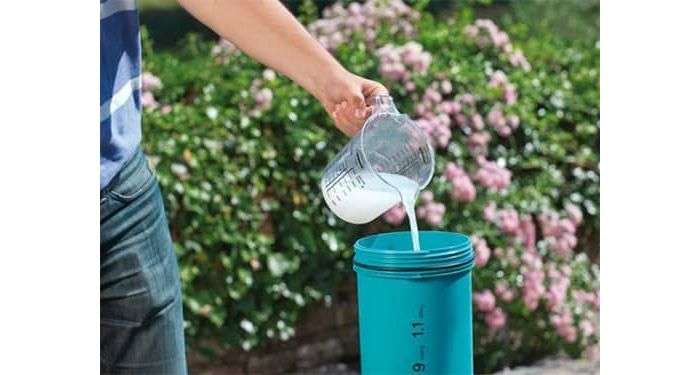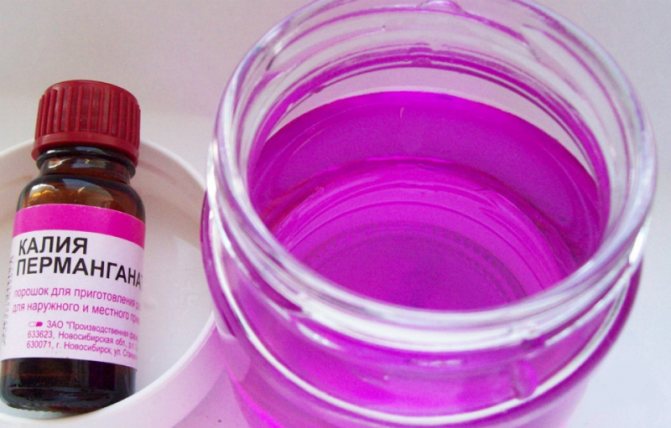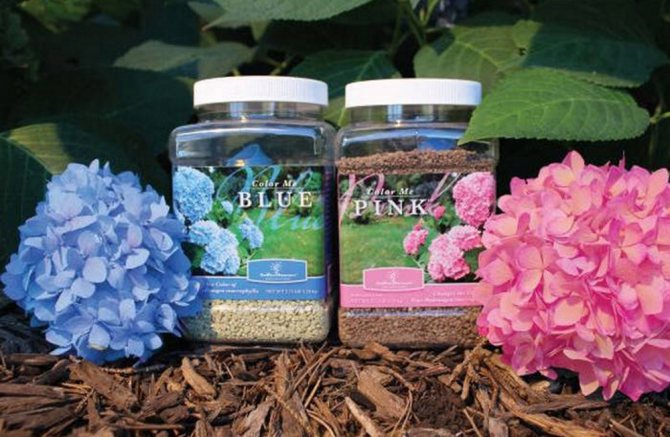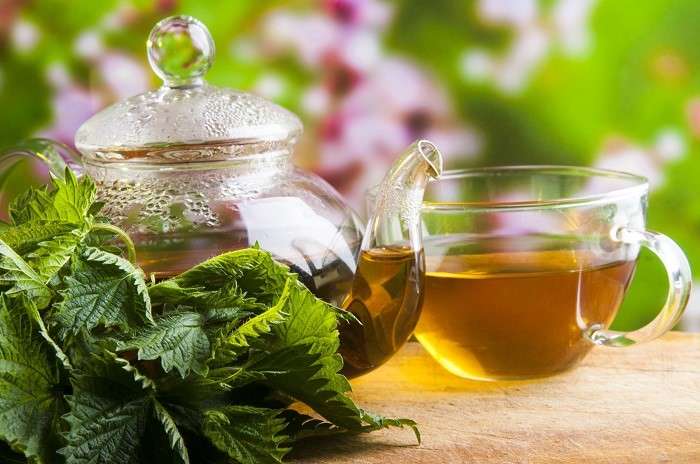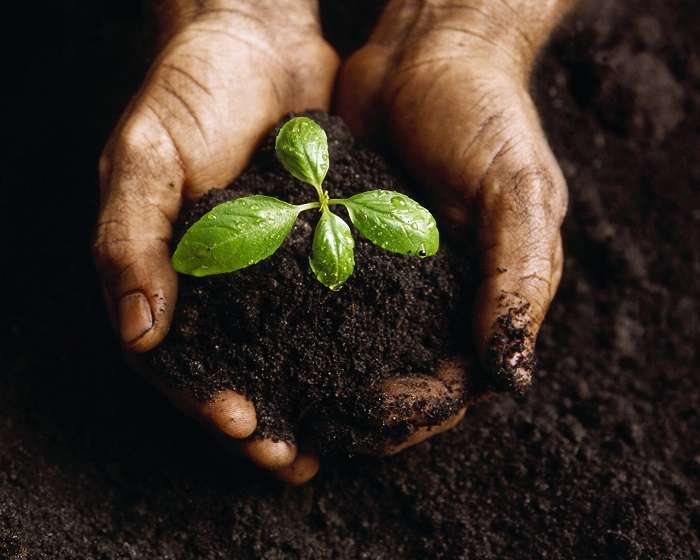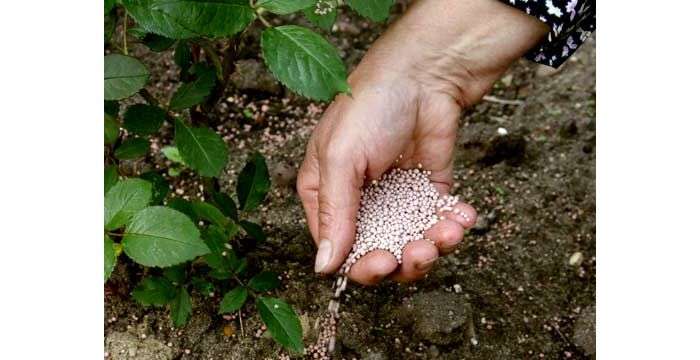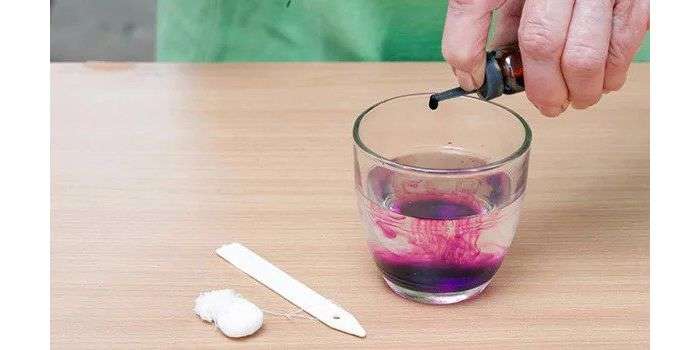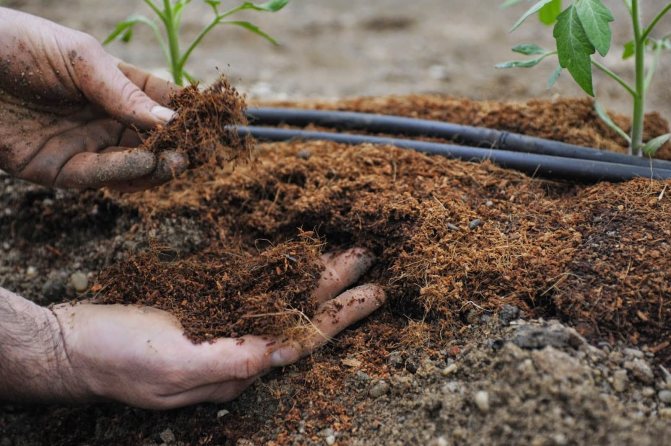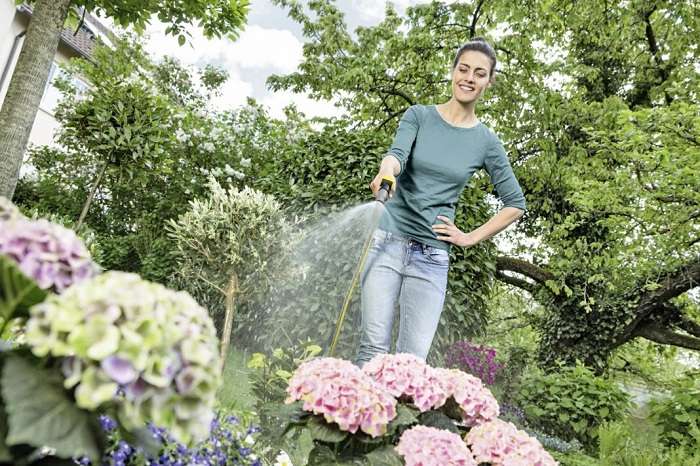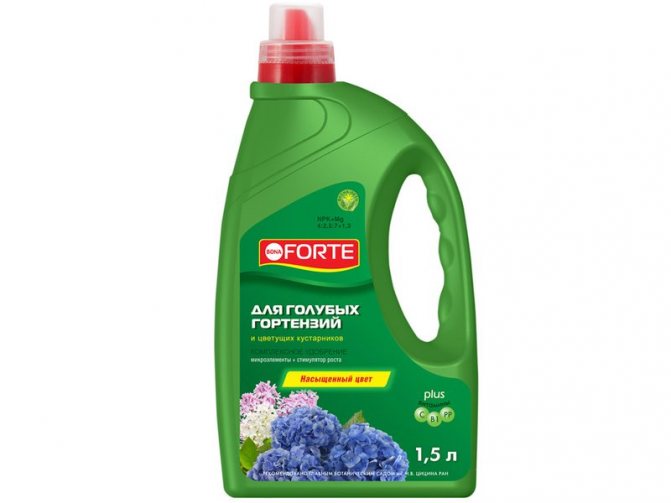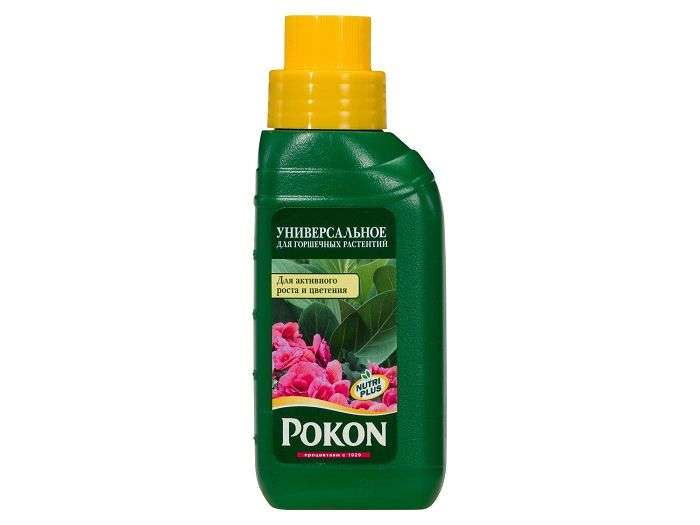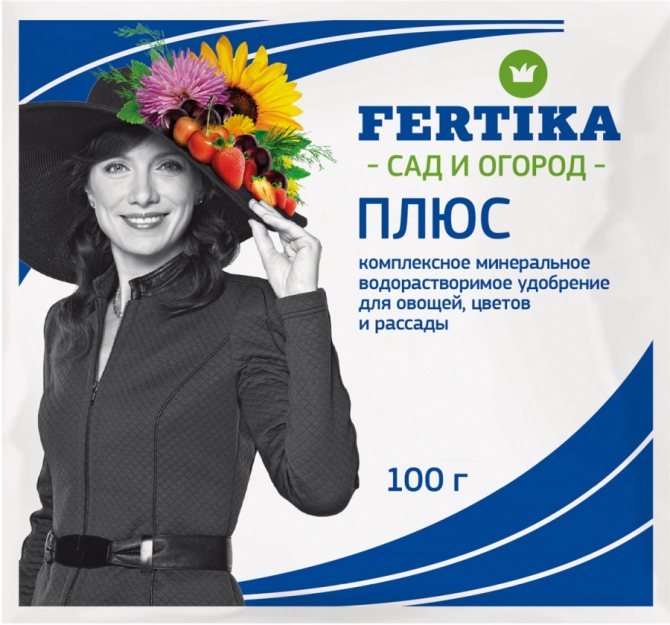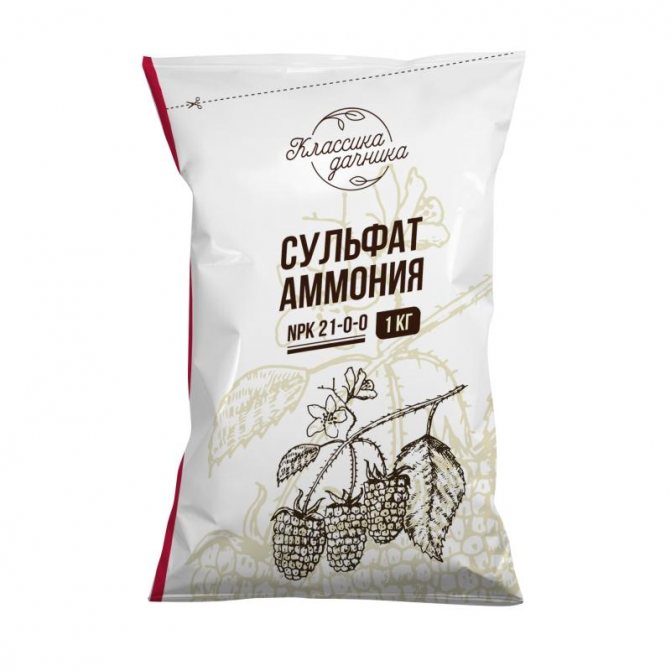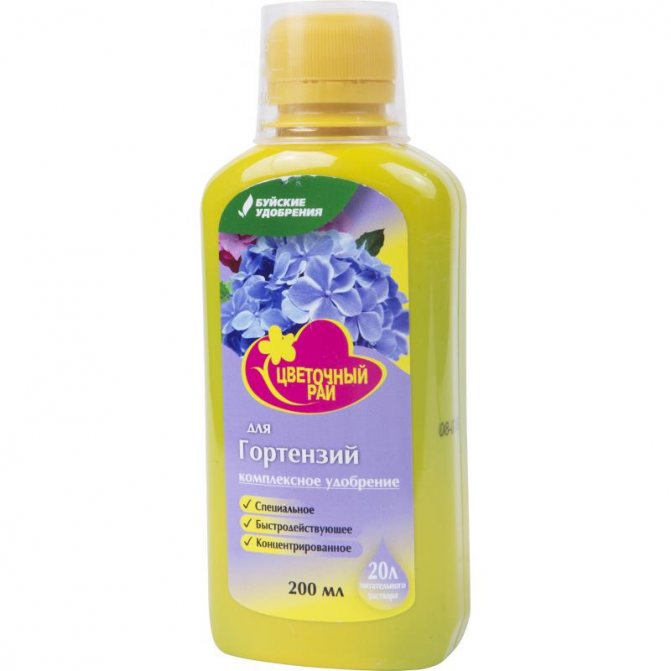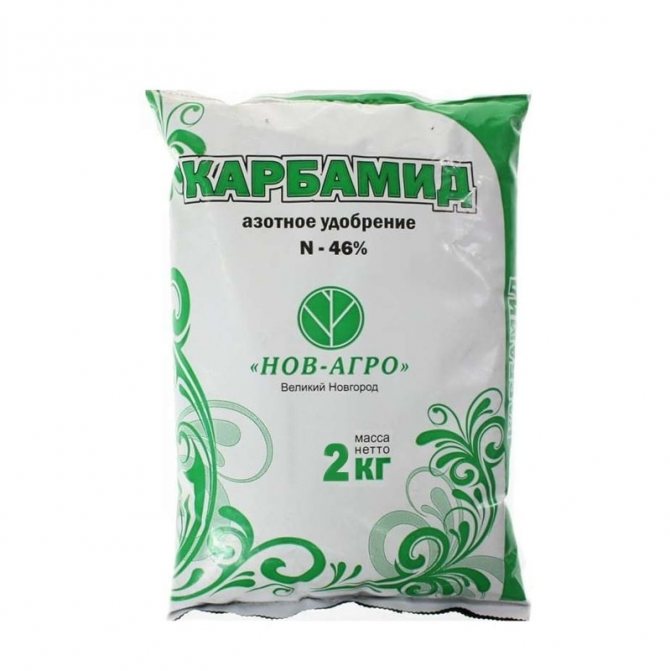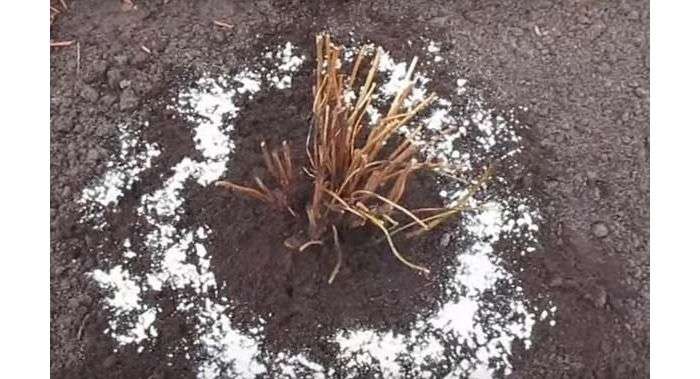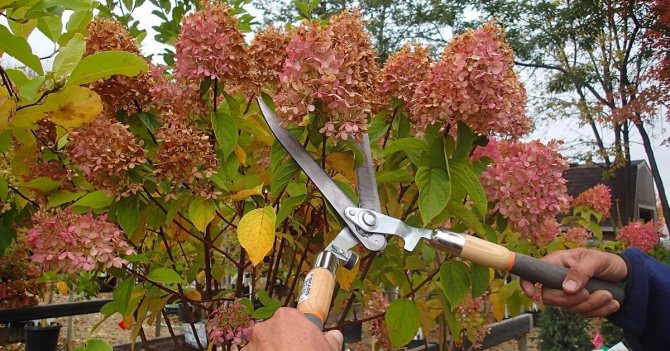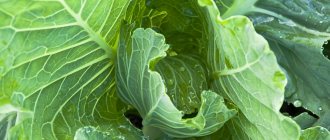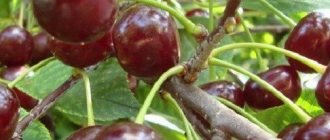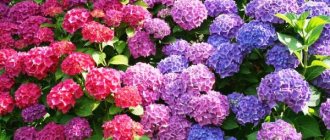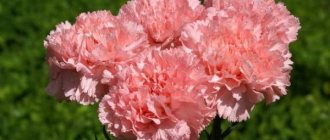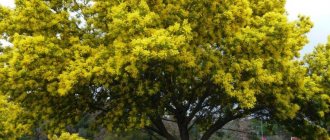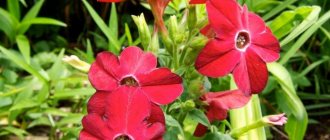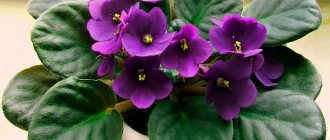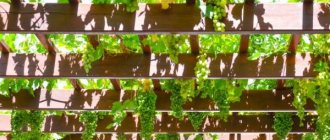Hydrangea is a beautiful flower that pleases both gardeners and housewives, growing both outdoors and feeling great in a pot. The plant is distinguished by a wide variety of petal colors, which also change color depending on the amount of minerals in the soil. To achieve the best results in growing, you need to know how to feed your hydrangea during flowering and throughout the warm season.
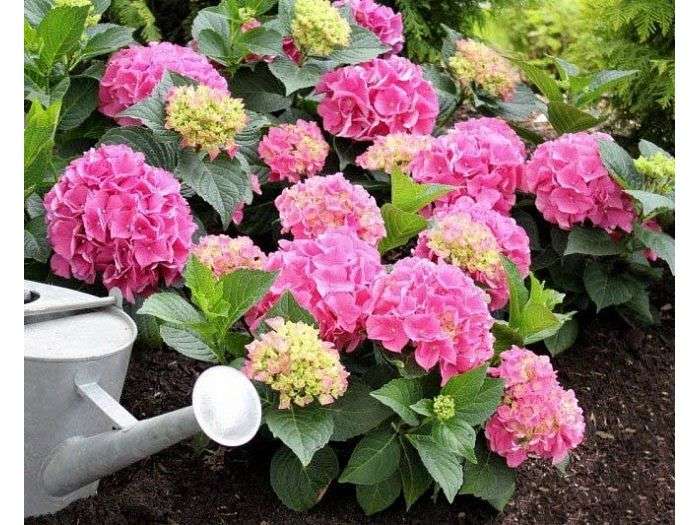
Features of hydrangeas
In gardens, in flower beds, in the backyard, hydrangeas are grown very often. In the open field, with an abundance of space, they give large peduncles, and the stems grow more powerful. But in order for the hydrangea to develop correctly, it needs to find a good place on the site.
- Large-leaved and treelike hydrangeas need diffused shade with an abundance of sunny color at dawn and dusk. During the day, these species do not tolerate the direct rays of the sun - burns may appear on the leaves and the development of the bush will slow down.
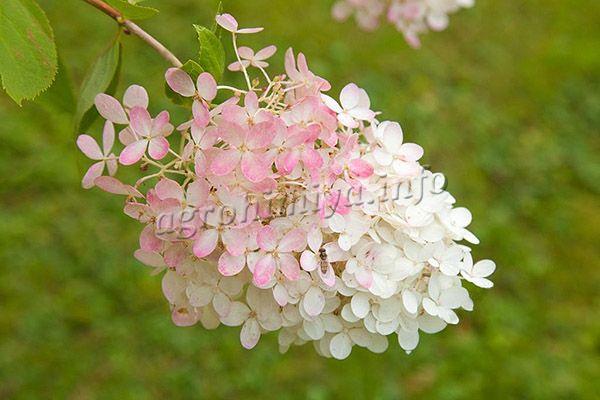

Hydrangea paniculata do not need special conditions
- Hydrangea paniculata do not need special conditions. It grows both in the sun and in a darkened area. However, in the shade, the brightness of the buds may suffer, and the number of flowers will be less.
The acidity of the earth should be in the range of 4.5-5.0. This is important to consider when choosing a fertilizer for garden hydrangeas, because many drugs greatly increase or decrease the acidity of the soil. A tree species can tolerate a neutral or slightly alkaline soil, but all other species react negatively to this (foliage turns pale, growth is inhibited, flowering either does not occur, or is very poor).
Important!
Large-leaved hydrangea or any other species that needs abundant watering. A lot of water evaporates through its large leaves, and this culture does not like drought.
The role of dressings in the growing season
Top dressing of hydrangeas is carried out throughout the entire growing season - in spring and summer. It is also necessary to regenerate the plant after flowering so that it gains strength to generate buds for the next season.
You can, of course, not engage in such painstaking work, but then the hydrangea will bloom less often, less and not so bright brushes. In nature, this is exactly what happens - there are periods when few of these or those elements get into the ground. Plants in such situations save their strength to survive, and bloom only in order to form seeds.
In the summer of July, to feed the panicle and tree hydrangea before flowering, the same mixtures are used in composition, since the preferences of these plants are identical. This is the most crucial period - if you skip it, the buds will be tied up small, will not last long on the stems. The sun burns flowers quickly if the plant is weakened.
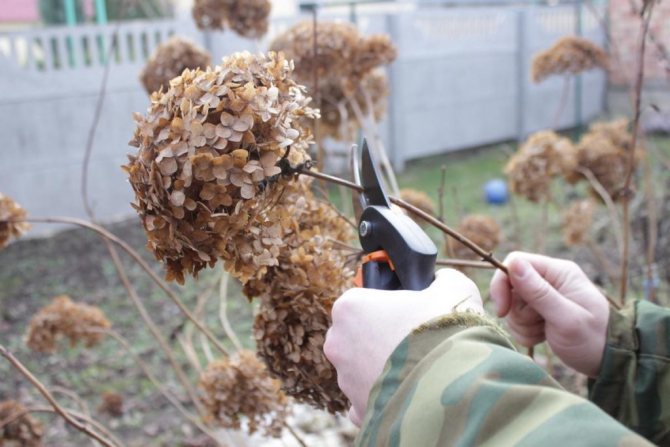

After such a period, hydrangea can recover for a long time and the next season will pass without inflorescences.
Fertilizer types for hydrangea
Check out these articles as well
- Treater Prestige
- Adhesives and their types
- Insecticide Confidor
- Fungicide Topaz
Usually gardeners prefer to take mineral fertilizers for hydrangeas, because they act quickly and are simple in terms of use. All types of mineral fertilizers for hydrangeas can be divided into several types.
| Fertilizer type | Brand name |
| Granular (dry) mixtures | Florovit, Biopon, Actiwin, Yara Vila |
| Water soluble (crystalline) | Master, Florovit, Agrecol, Planton |
| Liquid concentrates | Florovit |
| Fertilizers in granules (long-acting) | Target, Pokon |
To this list, it is also necessary to add superphosphate, urea, potassium sulfate, ammophos and similar drugs familiar to everyone.
Organic fertilizers can also be used for hydrangeas. The culture responds well to the introduction of whey, slurry, nettle infusion.
How to feed hydrangea in autumn
Preparing for winter is the main task of autumn feeding. For the development of the bush, the period of winter dormancy is very important. Hydrangea must meet the cold with strong shoots, full vigor, and a viable root system. This will help her easily survive the cold. The soil, depleted after vegetation and flowering, needs to be restored.
We offer several recipes for autumn hydrangea dressing, they are all effective and have their own characteristics:
- Organic feeding. It is carried out by mulching the surface around the bush with a layer of peat and humus. Mulch is both top dressing and insulation. Under the influence of moisture, the organic layer gradually decomposes, feeding the plant throughout the winter.
- Potassium-phosphorus mixture. Potassium protects the plant's root system from freezing, strengthening it. For hydrangeas, autumn feeding can raise the temperature, preventing the liquid inside the root from freezing. Phosphorus is responsible for plant immunity, increases its ability to resist disease. To prepare such a fertilizer, you need to take potassium sulfate and superphosphate one tablespoon at a time, dissolve in ten liters of water. This amount is enough to feed the bush over the age of five. For bushes under the age of five, take seven liters of solution.
- Mineral mixtures. They can be universal, contain magnesium, potassium, iron, phosphorus, boron. Usually, these are industrial fertilizing.
Remember that fertilizers containing nitrogen are not suitable for autumn dressing. Otherwise, feeding will cause the growth of new shoots, which will not mature until the first frost and the plant will freeze out. In addition, the growth of young shoots weakens the entire flower bush as a whole, reducing the number of buds formed.
Preparing the land for planting flowers
The first time the soil is fertilized before planting the bush. On sandy soil, add humus, compost in an amount of 10-15 l / m. sq. On rich soil, only a few minerals or organo-minerals can be applied (for example, Pokon extended-release fertilizer). If the earth with a pH reaction of 5.7-6.0 or higher, it is acidified (add sulfur 50 g / m. Sq.).
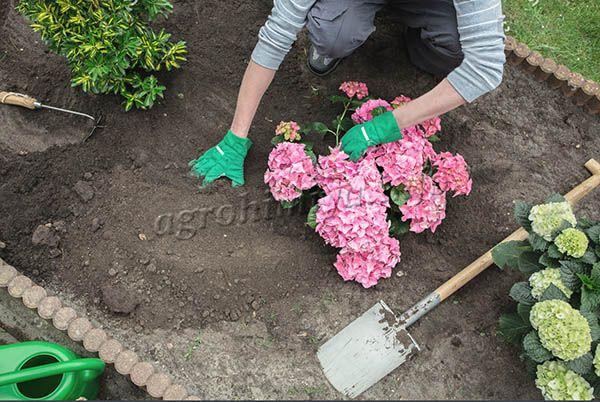

The first time the soil is fertilized before planting the bush
Important!
It is advisable to prepare a site for hydrangeas 2-4 weeks before planting. Then the acidity will have time to normalize, and the soil will become more nutritious due to the action of fertilizers.
If fertilizers were not applied to the ground during the preparation of the site, it is worth adding them during planting. For this, long-acting fertilizers (Pokon, OSMOKOT, Target, AVA or the like) are taken.
General recommendations and important nuances
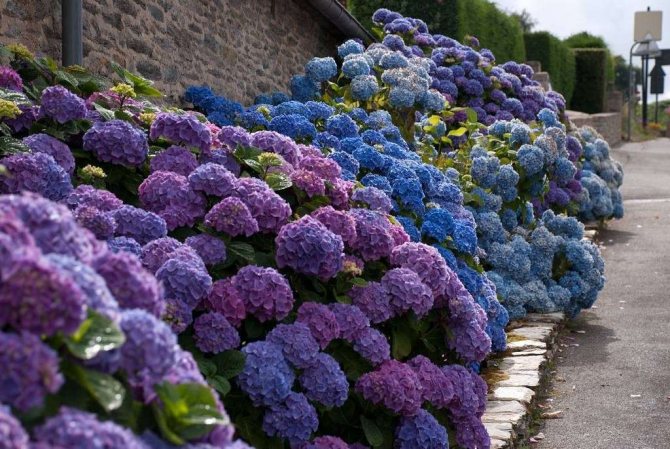

You should start feeding hydrangeas from the age of three.
Hydrangeas should be fed throughout the season (spring-autumn). But it is recommended to start carrying out the procedures not earlier than 2-3 years after planting the plants in open ground. Fertilizers need to be applied to a pre-moistened soil.
It should be remembered that an excess of nutrients is harmful to these shrubs much more than a lack of them. For this reason, it is necessary to strictly observe the dosages and adhere to the general application scheme.
There is a general scheme for feeding hydrangeas, but there are some important nuances, namely the shade of the flowers and the appearance.
Influence of dressings on the shade of flowers
If desired, the shade of hydrangea flowers can be changed by making certain dressings. To get bluish flowers, you should additionally feed the pink species with a weak solution of ammonia alum at the rate of 4 g per 1 liter of water. In this case, the introduction of reddish peat into the soil will help to consolidate the obtained result.
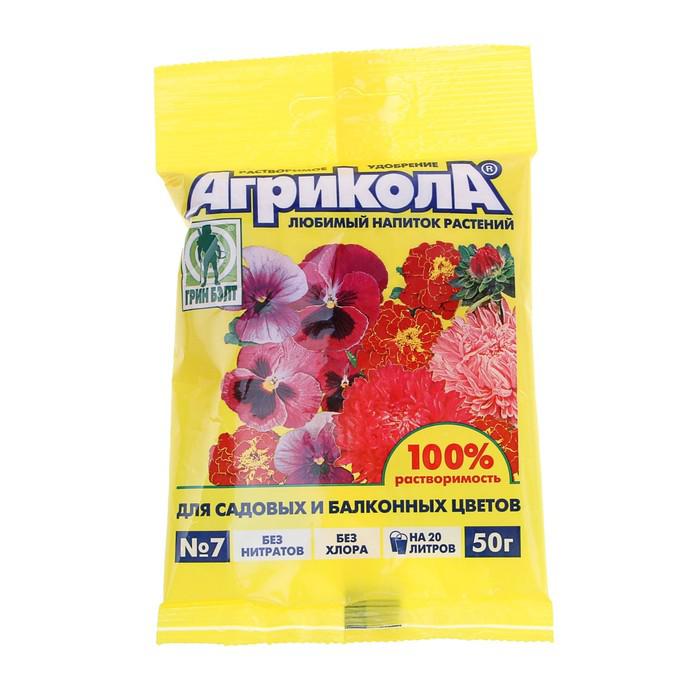

To obtain flowers of a rich pink hue, you should additionally feed the hydrangeas with Agricola for garden and balcony flowers.
In order for the pink inflorescences to become more saturated, they will need to be fertilized with potassium permanganate or Agricola for garden and balcony plants.


Bona Forte will help you to change the shade of flowers
In flower shops, a specialized color-changing agent Bona Forte is sold in the form of a liquid and a powder. This finished product is much easier to use to change the shade of hydrangea flowers.
It should be remembered that if initially the hydrangea flowers are white, it will not be possible to change their shade.
Video: how to change the color of a hydrangea
Features of feeding different types of shrubs
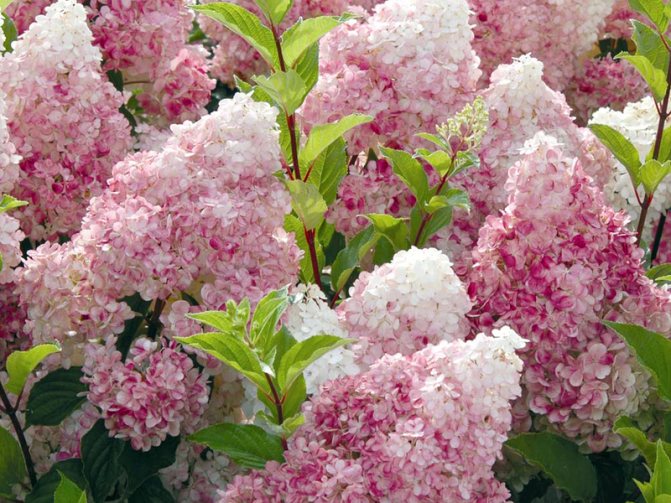

Spring feeding is most important for panicle hydrangeas
Each variety of this perennial shrub has certain characteristics that are recommended to be taken into account when feeding. For example, spring procedures are especially important for paniculate species. Such varieties respond well to organics. At the same time, dolomite flour is not suitable for them as a fertilizer.


It is advisable to fertilize tree hydrangeas with manganese solution
Treelike hydrangeas are fed according to the general scheme. But in addition, it is recommended to fertilize them several times per season with a manganese solution so that the shoots are more flexible and hardy.
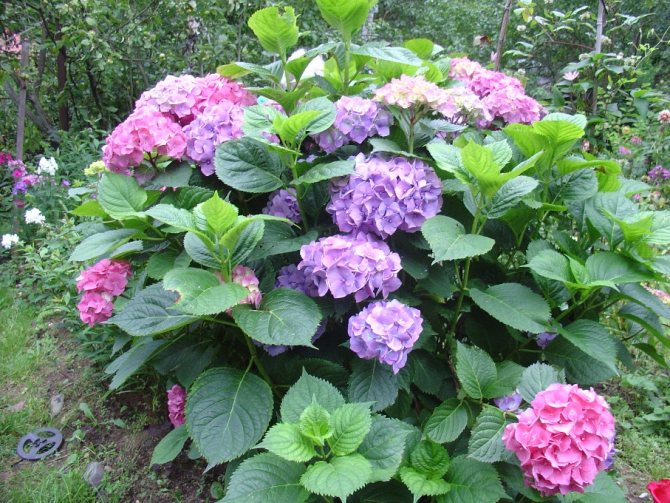

Large-leaved hydrangeas should be started to feed already in early spring.
Large-leaved hydrangeas require additional feeding at the beginning of the spring. As soon as the snow melts, it is recommended to fertilize the plants with a mixture of urea and potassium sulfate. Such feeding will help prepare shrubs for the growing season.
Rules for feeding hydrangeas in spring
We recommend reading our other articles
- How to grow an avocado from a seed
- Why do cucumber leaves turn yellow
- Growing beans outdoors
- How to get rid of midges in indoor flowers
After planting, hydrangeas begin to fertilize for 2 or 3 years. In the spring, preparations are usually made that stimulate the formation of foliage. From organic matter, you can add, for example, cow dung. For 10 liters of slurry, 3 liters of water are taken. After the liquid has fermented for a week, it is diluted with water in a ratio of 1:10 and used for root feeding. Top dressing is done 2 times with a break of half a month.
Important!
Foliar dressing, like root dressing, is recommended to be done in calm weather, at sunset, dawn or in cloudy weather.
Long-acting minerals are usually simply embedded in the soil (they are sold as granules). You can also choose nitrogen-potassium preparations. For example, 15 g of urea and 20 g of potassium sulfate are diluted in 10 liters of water. This mixture is poured over the bush once every half a month in an amount of 2 to 7 liters (depending on the size of the bush).


Estimated Fertilization Dates for Hydrangeas
Top dressing with folk remedies
Hydrangea also responds well to non-standard feeding.
- To prevent the attack of pests and improve the flexibility of the peduncles during the spring period, the shrubs are treated 3 times with a slightly pink solution of potassium permanganate.
- Once or twice a month, flowering plants are watered with this product. Store-bought low-fat kefir, homemade yogurt or whey are diluted in water, observing a ratio of 1: 4. These products will enrich the hydrangea with trace elements and protect against the development of fungal diseases.This solution is also used as a foliar dressing.
- Every 10-15 days, the bushes can be fertilized with sour bread. Put 1 kg of black bread crumbs or a pack of pressed yeast and a heaped tablespoon of granulated sugar in a bucket. All are poured with water at room temperature and placed in a warm place for a day. The fermented mass is watered with hydrangea, 1/2 capacity for each bush.
- Ornamental plants can be watered with herbal infusion every week. For its preparation, half of a large iron barrel is filled with chopped nettles, celandine, thistle, dandelion and filled with clean water. If desired, you can add a jar of iodine. The barrel is closed, the mass is stirred daily. After 12-14 days, the resulting mass is diluted with well water 1: 5. The solution contributes to the enrichment of the earth with microelements.
If the soil in the garden where the hydrangea grows is alkaline, then before planting and 3-4 times during the summer season, the soil should be thoroughly shed with "acidic" water. A tablespoon of acetic or citric acid is diluted in a bucket. Pour half a bucket onto an adult bush.
Summer fertilizers for hydrangeas
In summer, for hydrangeas paniculate, tree-like and large-leaved, it is necessary to add potassium and nitrogen. During this time, the plants produce flowers, so care must be taken to maintain their vigor. Top dressing is carried out 2-3 times a month and it is better to choose purchased mixtures specifically for flowering (Biopon, BioGrand, Planton, Bona Forte, etc.).
Usually, these fertilizers need to be dissolved in water. Dilution rates should be studied on the packaging in the instructions. After the nutrient fluid is received, it is poured onto the ground, with a distance of 20-30 cm from the bush (it is better to make a groove).
You can also do foliar feeding. For this, for example, the drug "Bud" is often chosen - 1 ml of substance per liter of water. Spraying is done during the opening of the first flowers and is repeated after 14 days.
From organic preparations, you can take an infusion of nettle for garden flowers - mix greens with water, leave to ferment. After 2 weeks, the liquid should darken, settle, then it is diluted with water in a ratio of 1:10 and used for irrigation. This fertilizer is used no more than 2 times per summer.
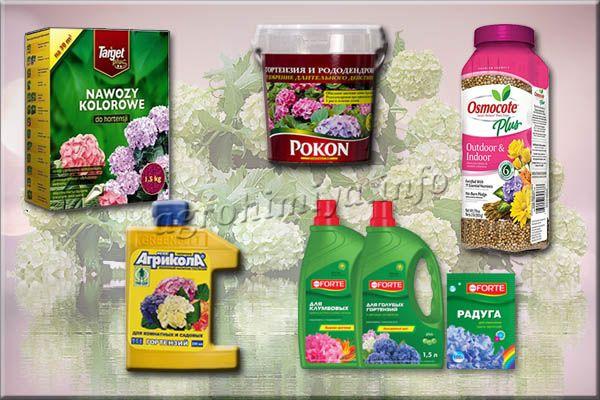

Long-acting fertilizers are taken for hydrangeas.
Fertilizers need to be changed from August. Preparations that do not harm should not contain nitrogen, but only phosphorus, potassium and trace elements. You can choose, for example, superphosphate, potassium sulfate (15 g and 25 g / m2 of soil). They are usually brought in dry for digging.
Reasons why top dressing is needed
To grow a blooming and colorful front garden on your garden plot, it is not enough to water the plants. Flowers are fed regularly. But an important part of all the manipulations is to choose a fertilizer mixture that is suitable for all types and varieties of "green inhabitants" around the house.
Hydrangeas, like all flowering shrubs, are extremely important to get 3 main elements:
- potassium for bud formation, active growth and development. The element should be supplied regularly, regardless of whether the feeding process takes place in May or September;
- phosphorus, which promotes abundant flowering and a luxurious green mass. Also, the element is responsible for strengthening the root system;
- nitrogen for active growth and development of all parts of the plant.
At the same time, certain trace elements supplement the list of essential substances for hydrangeas: magnesia, iron and others, no less important. With a lack of one or more enzymes, the immune system is weakened, which will lead to the appearance of necrosis, fungal infections and other diseases.
The reasons why it is important to feed the hydrangea in the fall, spring and sometimes in the summer include the need:
- saturation of green mass and the absence of chlorosis (hydrangeas are susceptible to this disease);
- stimulate the formation of buds, bright inflorescences;
- increased flowering time;
- increasing the intensity, for changing color, acquiring splendor, volume.
Need to know! For garden hydrangea, like other representatives of garden fauna, for normal life support, as many micro and macro elements as possible are required. This will help the plant to be resilient in all seasons, not just summer or spring. Much attention is paid to feeding in the fall, since at this moment the root system is preparing for the dormant stage.
After the introduction of complex fertilizer mixtures of organic or chemical origin, hydrangea (heat-loving flower) tolerates temperature extremes better.


It also perfectly tolerates winter cold, stress, and other unfavorable conditions during budding, development, growth. The decorative attractiveness is increased by 2-3 times.
But there is one important nuance: in those cases when, when planting hydrangeas, fertilizers were immediately applied (to the hole), then organic fertilizers or mineral fertilizers are not required for several years (no more than three).
What to bring in the fall
In the fall, hydrangeas begin to prepare for hibernation. They are no longer fed with nitrogen. But, in order to maintain the strength of the plant, you can apply 1-2 times fertilizer for hydrangea with potassium, magnesium and iron. They will increase the frost resistance of the culture, accelerate the ripening of the shoots.
Important!
From autumn, the amount of watering should be gradually reduced for all types of hydrangeas.
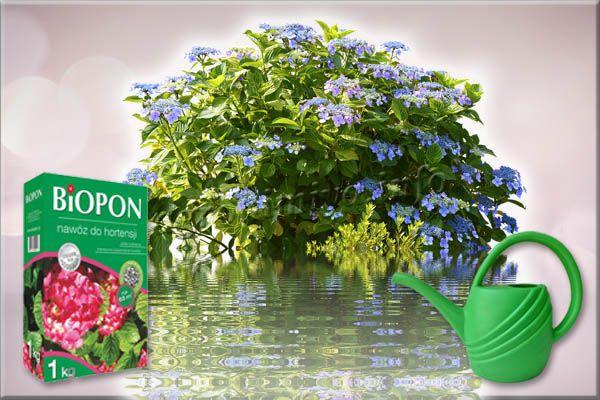

All dressings are combined with watering or done before the rain
Before the onset of frost, it is worth covering the ground near the bushes with mulch (compost, peat, humus). In this case, it is recommended to ensure that organics do not touch the branches, otherwise they may begin to rot. If the winters are very cold, frosty, it is also worth covering the bushes with insulating material.
When to apply top dressing, at what temperature
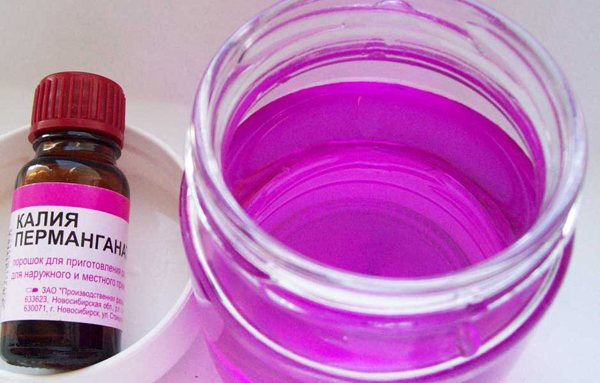

In the spring, hydrangeas need to be fertilized several times, alternating organic fertilizing and mineral complexes. It is recommended to feed the plant for the first time as soon as the snow melts, at slight positive temperatures. At this time, the hydrangea is just beginning to wake up completely from hibernation, fertilization will prepare the shrub for the beginning of the growing season. From the beginning of April to the end of May, manganese is fed three times, which strengthens the wood tissue.
On a note! It is necessary to adhere to the selected feeding scheme and strictly observe the dosage. Too high a concentration of salts leads to disruption of metabolic processes.
Fertilization rules
Fertilizers that are applied under the hydrangea should stimulate its growth, increase the abundance of green mass, provoke flowering, improve the color of the buds, prepare young shoots for ripening (before winter). For each stage of the development of the bush, certain elements are necessary, but there are general principles for the use of drugs, which are important to know so as not to harm the culture.
- All dressings are combined with watering or done before the rain. If you simply apply them to the ground, this can harm the roots or the elements of fertilizers will decay poorly (there will be no use from them).
- Many types of hydrangeas love acidified soil. For this, plants are watered 1-3 times a week with diluted electrolyte (10 ml / bucket of water), milk whey (solution 1: 3 with water), citric acid (1 tbsp. L / 10 l of water).
- Very often, professional gardeners recommend mulching the ground around the bushes with 3-4 cm pine needles (they acidify the soil). This can be done not only before winter, but also in summer, during extreme heat.
- If your favorite brand of fertilizers does not have a variety specifically for hydrangeas, you can take a preparation for azaleas or rhododendrons.
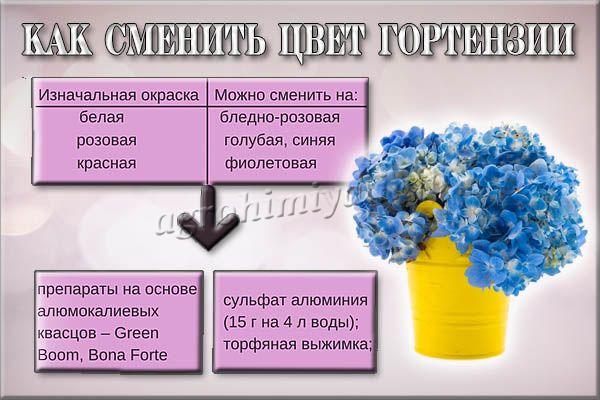

How to change the color of a hydrangea
Important!
Regardless of which fertilizer is chosen for paniculate, tree-like or large-leaved hydrangea, you should carefully study the instructions for use, the dosage of the drug, and the application rates.
- If signs of chlorosis appear, it is necessary to check the acidity of the soil and, if necessary, adjust it to 5.5 pH.
- It is recommended when growing garden hydrangeas to develop your own feeding system with alternating minerals and organics.
If the leaf blades turn yellow
Very often, hydrangea comes out of hibernation weakened. Her leaves grow slowly, and sometimes they begin to turn yellow. Most likely the reason for this trouble is the small amount of nitrogen in the soil. Foliar dressing with ammonia will become an "ambulance" for ornamental plants. After all, this liquid contains a large amount of ammonia, it can become a substitute for nitrogen fertilizer. Take 2-3 tablespoons of ammonia, dilute in a bucket of warm water. This miracle cure is sprayed on all shrubs from top to bottom. The treatment must be repeated after 12-14 days.
Yellowing of the leaf blades may indicate the presence of a disease called chlorosis. The plant can be easily healed if certain measures are taken. As soon as yellowness appears, the bushes are sprayed with a compound of ferrous sulfate and ferrous sulfate. For the solution, take 1 liter of pure water, 7 grams of each powder. After waiting 10 days, the procedure is carried out again.
Both summer and spring feeding of hydrangeas will protect the plant from diseases, especially from chlorosis, therefore, the color of the vegetative organs of the flower, their functions and development will be normal regardless of the conditions in which the plant grew. In addition, among the positive aspects of using fertilizers:
- Stimulation of uniform growth of buds;
- Increasing the duration of the flowering process;
- The pomp and volume of the buds;
- Intensity of color formation;
- The attractiveness of the appearance of flowers.
Thanks to top dressing, plants adapt better to changing environmental conditions. Hydrangea will grow beautiful, with spreading branches, regardless of temperature changes, lack or excess of water, humidity, amount of sunlight, and so on. External factors will practically not affect the attractiveness of flowers.

